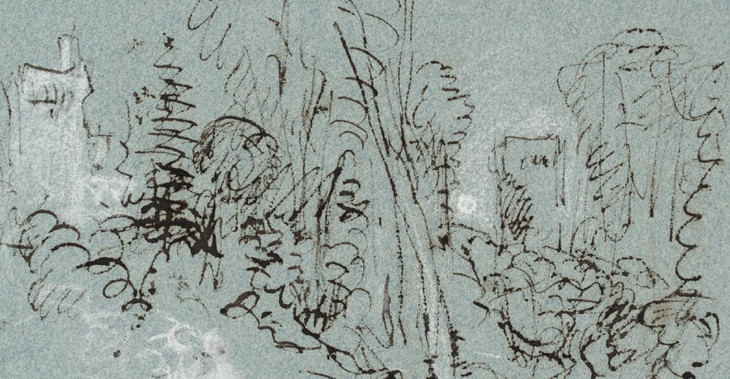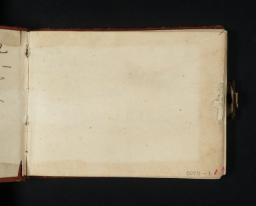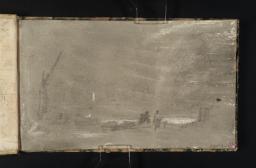Visit to the Isle of Wight and the 1827 Cowes Regatta, and Other South of England Subjects c.1827

From the entry
Turner enjoyed a leisurely stay on the Isle of Wight from late July to early September 1827 as a guest at East Cowes Castle, the self-designed home of his friend and patron, the prominent Regency architect John Nash (1752–1835). The artist had first toured the island at the age of twenty in 1795 to explore its Picturesque aspects (see the ‘Wales and Isle of Wight 1795–1800’ section of this catalogue), and in the following year his first exhibited oil painting, Fishermen at Sea (Tate T01585), was set off its coastline. East Cowes Castle, Nash’s battlemented country house in a playful medieval revival style, does not survive; it is described in detail in the Introduction to the subsection of drawings made in and around it on this occasion. Turner had been commissioned by Nash to make two paintings of the novel subject of the Cowes Regatta, then in its second year (for the 1826 event, see below), with his home shown in the distance. The Royal Yacht Squadron had been founded as the ...
Windsor and Cowes, Isle of Wight sketchbook 1827
D20596–D20732, D41014–D41018
Turner Bequest CCXXVI 1–81a
D20596–D20732, D41014–D41018
Turner Bequest CCXXVI 1–81a
Isle of Wight sketchbook 1827
D20733–D20762, D20764, D20766, D20768, D20770, D20772–D20777, D20779, D20781, D20783–D20803, D41004–D41006
Turner Bequest CCXXVII 1–43
D20733–D20762, D20764, D20766, D20768, D20770, D20772–D20777, D20779, D20781, D20783–D20803, D41004–D41006
Turner Bequest CCXXVII 1–43
D20316, D20384, D20412, D20455, D20804–D20816, D20819–D20904, D22690, D22694, D22705, D22722, D22761, D24841, D24845, D24847, D24848, D24861–D24868, D24871, D24872, D24897, D24898, D24965, D40083–D40085, D40306–D40309, D40521–D40526, D41420
Turner Bequest CCXXIV 26, 88, 114, 152, CCXXVII a 1–13, 16–57, CCXXVIII 1–44, CCXLIV 28, 32, 43, 60, 99, CCLX 5, 9, 11, 12, 25–32, 35, 36, 61, 62, 129
Turner Bequest CCXXIV 26, 88, 114, 152, CCXXVII a 1–13, 16–57, CCXXVIII 1–44, CCXLIV 28, 32, 43, 60, 99, CCLX 5, 9, 11, 12, 25–32, 35, 36, 61, 62, 129
References
Turner enjoyed a leisurely stay on the Isle of Wight from late July to early September 1827 as a guest at East Cowes Castle, the self-designed home of his friend and patron, the prominent Regency architect John Nash (1752–1835).1 The artist had first toured the island at the age of twenty in 1795 to explore its Picturesque aspects (see the ‘Wales and Isle of Wight 1795–1800’ section of this catalogue), and in the following year his first exhibited oil painting, Fishermen at Sea (Tate T01585),2 was set off its coastline.
East Cowes Castle, Nash’s battlemented country house in a playful medieval revival style, does not survive; it is described in detail in the Introduction to the subsection of drawings made in and around it on this occasion. Turner had been commissioned by Nash to make two paintings of the novel subject of the Cowes Regatta, then in its second year (for the 1826 event, see below),3 with his home shown in the distance. The Royal Yacht Squadron had been founded as the Yacht Club in London in 1815, and became the Royal Yacht Club on the accession of Nash’s patron the Prince Regent, a member since 1817, as George IV in 1820; based beside the River Medina at Cowes Castle (not to be confused with Nash’s home), it was given its present name by William IV in 1833.4 Racing took place in Cowes Roads, out beyond the mouth of the Medina within sight of East Cowes Castle, in the open waters of the Solent between the island and the Hampshire mainland to the north. There were two phases in 1827, between Tuesday 31 July and Thursday 2 August, and from Monday 13 to Friday 17 August;5 results for the first phase are tabulated in the Windsor and Cowes, Isle of Wight sketchbook (Tate D20730; Turner Bequest CCXXVI 80a).
Nash apparently provided Turner with ‘a painting room where he could work undisturbed’,6 albeit taking ‘the part of the resident and good-humoured artist of the weekend’ among more conventional high-society houseguests, as he did at Petworth later in the same year (see below).7 He even apparently gave small drawings as gifts on this occasion, as discussed in the Introduction to the ‘Cowes, the River Medina and Shipping’ subsection.8 His stay may have been longer than originally intended, as he wrote to his father in London three times on ongoing business matters and also to send more painting materials and clothes. The last of the letters is dated 8 September.9
The two commissioned paintings were exhibited at the Royal Academy in 1828. East Cowes Castle, the Seat of J. Nash, Esq.; the Regatta Beating to Windward (Indianapolis Museum of Art)10 is in a lively, dynamic mode ultimately deriving from Dutch sea painting, while East Cowes Castle, the Seat of J. Nash, Esq.; the Regatta Starting for their Moorings (Victoria and Albert Museum, London)11 with its low central sun, recalls the calmer, classical harbour scenes of Claude Lorrain (1604/5–1682), often emulated by Turner.12 East Cowes Castle is notably inconspicuous in each painting, as compared for example with its prominence and centrality in an engraving by George Brannon from a set published privately by Nash from 1825.13
There are also nine oil sketches, painted on two strips of canvas and only separated in the early twentieth century, six of which relate to the two paintings:
Further oil sketch subjects were left undeveloped: an unusual scene of the interior of a large warship, Between Decks (Tate N01966),20 Shipping off East Cowes Headland (Tate N01999),21 and a generic Study of Sea and Sky, Isle of Wight (Tate N02001).22 There has been much discussion as to whether they were made in the open air23 or, perhaps more likely from what is known of Turner’s general practice,24 partly or entirely back at East Cowes Castle. For further discussion see the introduction to the Cowes Regatta sketchbook (Tate; Turner Bequest CCVII).
The painting Dido Directing the Equipment of the Fleet, or the Morning of the Carthaginian Empire (Tate N00506)25 was also exhibited at the Royal Academy in 1828, and may have been begun on the island.26 Its general arrangement has some points in common with the Starting for their Moorings painting as well as echoes of previous Claude-like paintings from the story of ancient Carthage such as The Decline of the Carthaginian Empire of 1817 (Tate N00499).27 Small blue paper sketches for it include Tate D20818 (Turner Bequest CCXXVII a 15), grouped in Finberg’s Inventory with the East Cowes Castle studies,28 and Tate D24843, D24844, D24846 (Turner Bequest CCLX 7, 8, 10); these are all covered elsewhere in this catalogue. Another painting, Boccaccio Relating the Tale of the Birdcage, was shown on the same occasion, and was inspired by the atmosphere and setting of East Cowes Castle (see under Tate D20844; Turner Bequest CCXXVII a 41).
The sketchbooks and blue paper studies addressed here include those traditionally associated with the visit: the Windsor and Cowes, Isle of Wight and Isle of Wight sketchbooks (Turner Bequest CCXXVI, CCXXVII), and the separate sheets from the 1909 Inventory sections ‘East Cowes Castle’ and ‘Yachts, &c. at Cowes’ (Turner Bequest CCXXVII a, CCXXVIII), arranged in equivalent subsections in the present catalogue. There are numerous additional sheets from other Inventory sections; Turner used blue paper in France and elsewhere around this time (see the technical notes to the East Cowes Castle subsection); perhaps scattered in the studio, a few identifiable Isle of Wight subjects had become associated with his Continental tours, and also with his subsequent stay at Petworth House.
The major addition here is the sketchbook known until now as ‘Gosport’ and traditionally dated to about 1823–4 (Turner Bequest CCVII). It is here renamed and redated as the Cowes Regatta sketchbook, on the basis of the many pencil studies which can be related in spirit and sometimes in detail and composition to the oil studies and paintings; specific comparisons are listed in its Introduction.
A complication to an 1827 narrative is the possibility of an otherwise undocumented, ‘previously unknown trip’29 to the island in 1826, proposed by Ian Warrell.30 In that year Turner had exhibited a painting, View from the Terrace of a Villa at Niton, Isle of Wight, from Sketches by a Lady (Museum of Fine Arts, Boston),31 commissioned by the amateur artist Lady Gordon (née Julia Bennet, 1775–1867; see Tate T08138), a contemporary, early pupil and friend32 whom he had tutored in 1797 by means of her copying his watercolours, including Tate D00667 (Turner Bequest XXVII F).33 The Niton painting was based on Lady Gordon’s own work,34 which seems to indicate recent contact, although no correspondence survives between the artist and the Gordons.35 Warrell has suggested that the payment noted for the picture on 20 July 1826 could have been made upon its delivery by Turner himself,36 and that the artist may have lingered on the island to see the events of the first Cowes Regatta on 10 and 11 August that year.37 He has further suggested that the Gosport and Isle of Wight sketchbooks might relate to that occasion, ahead of his French tour a few weeks later, rather than the 1827 races.38 Since Gosport includes many drawings which seem closely related to the two Nash paintings, and Isle of Wight includes a view from the roof of East Cowes Castle (Tate D20757; Turner Bequest CCXXVII 16a) comparable with others among the blue paper drawings from Turner’s 1827 stay there, but none identifiable as showing the area around the Gordons’ Niton home at the southern tip of the island, they are here dated to 1827 along with the Windsor and Cowes, Isle of Wight sketchbook, with its table of 1827 regatta results.
With regard to Turner’s prolonged stay with Nash in 1827, Warrell has proposed that Turner may have first visited the Gordons at Niton, partly to deliver a second painting, the Scene in Derbyshire exhibited at the Royal Academy that year (Musée national des beaux-arts du Québec),39 for which payment is recorded on 26 July;40 a personal transaction on that date would fit with the traditional timing of the beginning of Turner’s time with Nash. An inscription possibly relating to a friend of Lady Gordon’s is in the Windsor and Cowes, Isle of Wight sketchbook (Tate D20698; Turner Bequest CCXXVI 64). Warrell has also suggested that Turner might have briefly visited France during the course of his stay, albeit noting that the volume of Isle of Wight material he produced in little over a month and the lack of specific candidates among the French subjects probably precludes this.41
Warrell has tentatively associated watercolours of Carisbrooke Castle with the proposed 1826 visit; pending further evidence, a related pencil drawing (Tate D20316; Turner Bequest CCXXIV 26) is included with the blue paper drawings here. There are numerous views of Norris Castle, commanding the Solent near East Cowes Castle, in the Windsor and Cowes Isle of Wight sketchbook (see under Tate D20658; Turner Bequest CCXXVI 38); see also the Cowes Regatta book, under Tate D17992 (Turner Bequest CCVII 1a). Their number seems too great to be fortuitous, and might suggest that Turner had in mind the possibility of a separate commission from its owner, Lord Henry Seymour, but if so nothing came of it; perhaps Nash might not have approved of Turner producing so similar a subject for a neighbour. Meanwhile, there are sketches of River Thames subjects for watercolours to be engraved for the ongoing Picturesque Views in England and Wales project in both the Windson and Cowes, Isle of Wight and Isle of Wight books.
Upon returning to the mainland in 1827, Turner was staying at Petworth House in Sussex, the home of one of his major aristocratic patrons, the Earl of Egremont, before the end of October. He had just possibly been there before cossing to the island, having happened to meet Egremont early in July. The autumn Petworth visit marked the start of a series of extended residencies there, and was apparently the occasion of a well-known series of gouache and watercolour studies on blue paper (mostly Tate; Turner Bequest CCXLIV), addressed in a separate section of the present catalogue, comparable with the largely monochrome blue paper works made on the Isle of Wight.42
In 1831 Nash bought a painting exhibited at the Royal Academy, Life-Boat and Manby Apparatus Going Off to a Stranded Vessel Making Signal (Blue Lights) of Distress (Victoria and Albert Museum, London).43 Turner was reportedly at East Cowes Castle again at Christmas 1832,44 and may possibly have crossed to the island once more, in November 1833.45 A painting of about 1835 currently known as Music Party, East Cowes Castle (Tate N03550)46 may be related to the 1832 visit,47 although there are in any case slight sketches of the interiors there among the 1827 blue paper studies here. That painting had previously been associated with Petworth, as has the one now called Interior of a Great House: The Drawing Room, East Cowes Castle (Tate N01988;48 see also under Tate D22694 and D22761; Turner Bequest CCXLIV 32, 99), demonstrating the fluid interplay of places, situations, history and ideas in Turner’s less formal works at this time.
For general accounts of the 1827 visit and the subsequent paintings informing the present account, see Finberg 1961, pp.302–4, Reynolds 1969a, pp.123–4, Reynolds 1969b, pp.67–79; Herrmann 1981, p.12, Butlin and Joll 1984, pp.159–60, 162, Lindsay 1985, p.104, Wilton 1987, pp.166–7, Warrell 1991, pp.13, 65, Krauze 1997, p.158, Joll 2001, pp.66–7, Kennedy 2001, p.150, Riggs 2001, pp.198–9, Warrell 2002, pp.56, 58, 187–8, Hamilton 2003, pp.15–16, 18, Wilton 2006, p.237 and Warrell 2015, pp.162–171
See ‘About RYS: History’, Royal Yacht Squadron, accessed 23 November 2015, http://www.rys.org.uk/about/history .
See John Gage, Collected Correspondence of J.M.W. Turner with an Early Diary and a Memoir by George Jones, Oxford 1980, pp.108–10 no.123–5; also quoted in Finberg 1961, pp.303–4.
Butlin and Joll 1984, p.150 no.242, pl.246 (colour); see aslo Krauze 1997, p.158 no.47, reproduced in colour p.159.
Butlin and Joll 1984, pp.150–1 no.243, pl.247 (colour); see also Ronald Parkinson, Victoria & Albert Museum: Catalogue of British Oil Paintings 1820–1860, London 1990, p.284.
See Ian Warrell and others, Turner Inspired: In the Light of Claude, exhibition catalogue, National Gallery, London 2012.
See Reynolds 1969b, pp.67, 72, Herrmann 1981, p.12, Lindsay 1985, p.104, Krauze 1997, p.158, Joll 2001, pp.66–7, Hamilton 2003, p.16, and Warrell 2015, p.170.
See Evelyn Joll, ‘Gordon, Sir Willoughby and Lady’ in Joll, Butlin and Herrmann 2001, pp.128–9; see also Warrell 2015, pp.158–9.
See Evelyn Joll, ‘Gordon, Sir Willoughby and Lady’ in Joll, Martin Butlin and Luke Herrmann (eds.), The Oxford Companion to J.M.W. Turner, Oxford 2001, p.128.
See for example Ian Warrell, Turner on the Loire, exhibition catalogue, Tate Gallery, London 1997, fig.178.
Butlin and Joll 1984, pp.148–9 no.240, as untraced, and p.162 no.269, as ‘Near Northcourt in the Isle of Wight’, c.1827, pl.241 (colour); a third painting commissioned by the Gordons (with another confused history) was The Banks of the Loire (Worcester Art Museum, Worcester, Massachusetts), exhibited at the Royal Academy in 1829: Butlin and Joll 1984, p.182 no.328a, as ‘View on the Rhone?’, and p.183 no.329, as untraced, pl.332 (colour); for the latter see Warrell 1997, pp.181–3, 225 no.100.
For a concise summary, see Ian Warrell, ‘Petworth’ in Joll, Butlin and Herrman 2001, pp.226–7; for dates see also Warrell 2002, pp.187–8.
How to cite
Matthew Imms, ‘Visit to the Isle of Wight and the 1827 Cowes Regatta, and Other South of England Subjects c.1827’, October 2015, in David Blayney Brown (ed.), J.M.W. Turner: Sketchbooks, Drawings and Watercolours, Tate Research Publication, November 2016, https://www





